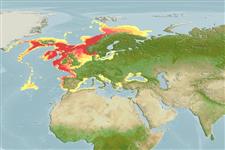Echinoidea |
Spatangoida |
Brissidae
Environment: milieu / climate zone / depth range / distribution range
Ecology
Benthic; depth range 4 - 1500 m (Ref. 85345). Temperate
Northeast Atlantic and the Mediterranean: Europe. Temperate and subtropical.
Length at first maturity / Size / Weight / Age
Maturity: Lm ? range ? - ? cmmax. reported age: 4 years (Ref. 2823)
A subsurface deposit feeder (Ref. 96501). Found offshore at a depth of 80 m (Ref. 2823).
Life cycle and mating behavior
Maturity | Reproduction | Spawning | Eggs | Fecundity | Larvae
Members of the class Echinoidea are gonochoric. Fertilization is external. Brooding is common, eggs are held either on the peristome, around the periproct or deep into the concavities on the petaloids. Life cycle: Embryos develop into planktotrophic larvae (echinoplateus) and live for several months before they sink to the bottom using their tube feet to adhere on the ground where they metamorphose into young urchins.
Harms, J. 1993 Check list of species (algae, invertebrates and vertebrates) found in the vicinity of the island of Helgoland (North Sea, German Bight) - a review of recent records. Helgoländer Meeresunters 47:1-34. (Ref. 2711)
IUCN Red List Status
(Ref. 130435: Version 2025-1)
CITES status (Ref. 108899)
Not Evaluated
Not Evaluated
Threat to humans
Human uses
| FishSource |
Tools
More information
Trophic EcologyFood items (preys)
Diet composition
Food consumption
Predators
Life cycleReproductionMaturityFecunditySpawningEggsEgg developmentLarvae PhysiologyOxygen consumption
Human RelatedStamps, coins, misc.
Internet sources
Estimates based on models
Preferred temperature
(Ref.
115969): 2 - 10.4, mean 7.1 (based on 217 cells).
Price category
Unknown.
